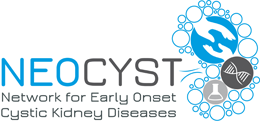Congenital oculomotor apraxia type Cogan II is characterized by impairment of horizontal voluntary eye movements and optokinetic nystagmus. Patients cannot perform horizontal eye movements for ocular fixation of an object. Therefore they make characteristic jerky movements of the head into the wanted direction trying to permanently fix an object. As a consequence patients often show ataxic gait and the typical head movements that improve with age. The clinical picture is often aggravated by muscular hypotension that combined with the described ataxia leads to motor development delay. COMA is rarely associated with NPH and is only described in mutations of NPHP1, 4, 6 and 8. Recently we identified in our own cohort patients with a compound heterozygous pathogenic mutation in TMEM67/NPHP11.
CONGENITAL OCULOMOTOR APRAXIA TYPE COGAN II (COMA) - summary
| synonyms |
|
| main symptoms |
|
| additional findings |
|
| manifestation | newborns |
| frequency | unclear, rare |
| inheritance | autosomal – recessive |
| pathogenesis | Mutations found in NPHP1, 4, 6, 8 and 11. Exact pathomechanism not clear. |
| progress and prognosis | Jerky movements of the head as well as muscular hypotonia and ataxic gait improve with age. Attendance at a regular school is most often possible. |
| treatment | No causal treatment available. Symptomatic therapy of ataxia with physiotherapy and treatment of chronic renal failure. |
sources
- Betz R, Rensing C, Otto E, et al. Children with ocular motor apraxia type Cogan carry deletions in the gene (NPHP1) for juvenile nephronophthisis. J Pediatr. 2000;136:828–831.
